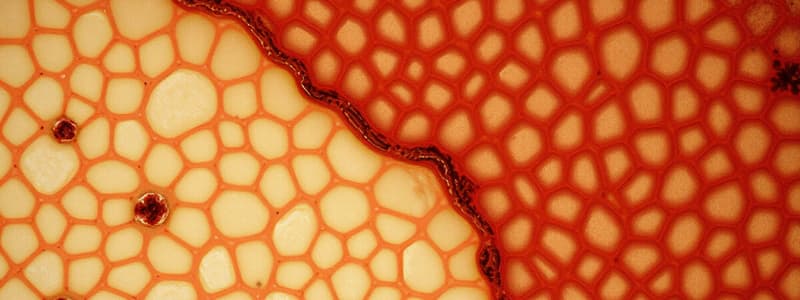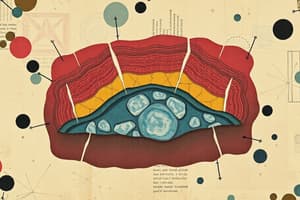Podcast
Questions and Answers
What type of cartilage is characterized by a high content of elastic fibers?
What type of cartilage is characterized by a high content of elastic fibers?
- Fibrocartilage
- Hyaline cartilage
- Elastic cartilage (correct)
- Bone cartilage
Which type of bone tissue is organized into repeating structural units known as osteons?
Which type of bone tissue is organized into repeating structural units known as osteons?
- Medullary bone
- Spongy bone
- Woven bone
- Compact bone (correct)
What is the primary characteristic of fibrocartilage that differentiates it from other types of cartilage?
What is the primary characteristic of fibrocartilage that differentiates it from other types of cartilage?
- High number of chondrocytes
- Presence of osteocytes
- Thick collagen fibers (correct)
- Elastic fibers predominance
What connects the lacunae in bone tissue to larger canals containing blood vessels?
What connects the lacunae in bone tissue to larger canals containing blood vessels?
Which type of muscle tissue is characterized by voluntary control?
Which type of muscle tissue is characterized by voluntary control?
What type of connective tissue is composed of red blood cells, white blood cells, platelets, and plasma?
What type of connective tissue is composed of red blood cells, white blood cells, platelets, and plasma?
What is the role of neuroglia in nervous tissue?
What is the role of neuroglia in nervous tissue?
Which muscle type is primarily found in the heart and operates involuntarily?
Which muscle type is primarily found in the heart and operates involuntarily?
What is the primary function of simple squamous epithelium?
What is the primary function of simple squamous epithelium?
Which type of epithelium contains goblet cells?
Which type of epithelium contains goblet cells?
What is the main function of transitional epithelium?
What is the main function of transitional epithelium?
Where is stratified squamous epithelium typically found?
Where is stratified squamous epithelium typically found?
What type of connective tissue has loosely arranged fibers in the extracellular matrix?
What type of connective tissue has loosely arranged fibers in the extracellular matrix?
What distinguishes pseudostratified columnar epithelium from other epithelium types?
What distinguishes pseudostratified columnar epithelium from other epithelium types?
Which type of epithelium is most commonly found in gland ducts?
Which type of epithelium is most commonly found in gland ducts?
Which statement about stratified cuboidal and columnar epithelium is true?
Which statement about stratified cuboidal and columnar epithelium is true?
What is the primary function of elastic fibers in connective tissue?
What is the primary function of elastic fibers in connective tissue?
Which of the following connective tissues contains the most abundant extracellular matrix?
Which of the following connective tissues contains the most abundant extracellular matrix?
What type of connective tissue is characterized by parallel bundles of collagen fibers?
What type of connective tissue is characterized by parallel bundles of collagen fibers?
In which connective tissue type do chondrocytes reside within lacunae?
In which connective tissue type do chondrocytes reside within lacunae?
Which type of cartilage contains fine collagen fibers and is the most predominant type in the body?
Which type of cartilage contains fine collagen fibers and is the most predominant type in the body?
Which tissue type is characterized by a higher number of adipocytes and minimal extracellular matrix?
Which tissue type is characterized by a higher number of adipocytes and minimal extracellular matrix?
What distinguishes dense irregular connective tissue from dense regular connective tissue?
What distinguishes dense irregular connective tissue from dense regular connective tissue?
What is the primary component of the ground substance in connective tissue?
What is the primary component of the ground substance in connective tissue?
Flashcards are hidden until you start studying
Study Notes
Body Tissues
- Composed of groups of similar cells.
- Four primary tissue types: Epithelial, Connective, Muscular, Nervous.
Simple Epithelia
- Functions include absorption, secretion, filtration, and act as selective barriers.
- Generally thin, focusing on exchange rather than protection.
- Types:
- Simple Squamous Epithelium: Forms membranes for rapid diffusion; found in air sacs of lungs and capillary walls; contributes to serous membranes of body cavities.
- Simple Cuboidal Epithelium: Common in glandular ducts and kidney tubules; covers ovarian surfaces.
- Simple Columnar Epithelium: Lines digestive tract; contains goblet cells for mucus production; can be ciliated or nonciliated.
- Pseudostratified Columnar Epithelium: Appears layered but is a single layer; involved in absorption and secretion.
Stratified Epithelia
- Primarily provides protection.
- Types:
- Stratified Squamous Epithelium: Most common; surface cells are squamous, with deeper cells being cuboidal or columnar; found in esophagus, mouth, vagina, and skin.
- Stratified Cuboidal Epithelium: Rare, found in large gland ducts.
- Stratified Columnar Epithelium: Also rare, located in some gland ducts.
- Transitional Epithelium: Modified stratified epithelium; lines urinary bladder and ureters; cells can change shape.
Types of Connective Tissue
- Loose Connective Tissue: Fibers loosely arranged, includes areolar, reticular, and adipose tissue.
- Areolar Tissue: Most abundant type; contains various cells and fibers in a semi-fluid ground substance.
- Reticular Tissue: Features a net-like arrangement of fibers.
- Adipose Tissue: Specialized for fat storage with fewer fibers.
- Dense Connective Tissue: Packed with fibers, little ground substance; includes dense regular and irregular connective tissues.
- Dense Regular Connective Tissue: Contains parallel collagen fibers; often called white fibrous tissue.
- Dense Irregular Connective Tissue: Has irregularly arranged fibers providing strength from multiple directions.
- Elastic Connective Tissue: Dominated by elastic fibers, allowing stretch and recoil.
Cartilage
- Extracellular matrix with collagen and elastic fibers in gel-like ground substance.
- Chondroblasts secrete fibers; turn into chondrocytes in lacunae (spaces).
- Types of cartilage:
- Hyaline Cartilage: Most common, with fine collagen fibers; smooth surface for joint movement.
- Elastic Cartilage: Contains dense elastic fibers, allowing flexibility.
- Fibrocartilage: Dense with thick collagen fibers, providing tensile strength; found in intervertebral discs.
Bone
- Organized in layers (lamellae); consists of collagen fibers, ground substance, and inorganic salts.
- Osteocytes: Mature bone cells located in lacunae; communicate via canaliculi (small canals).
- Types:
- Compact Bone: Features osteons, structural units centering on a central canal.
- Spongy Bone: Lattice-like arrangement called trabeculae; contains larger spaces.
Blood
- Composed of red blood cells, white blood cells, platelets, and plasma.
- Plasma acts as the extracellular matrix.
Muscle Tissue
- Highly vascularized, consisting mainly of elongated muscle fibers capable of contraction.
- Types:
- Skeletal Muscle: Voluntary control, striated appearance.
- Cardiac Muscle: Involuntary control, striated, found in heart.
- Smooth Muscle: Involuntary, non-striated, found in walls of hollow organs.
Nervous Tissue
- Forms the brain, spinal cord, and nerves; very cellular.
- Comprises:
- Neurons: Responsible for transmitting information.
- Neuroglia: Supportive cells aiding neuron functionality; include various types serving diverse roles in the nervous system.
Studying That Suits You
Use AI to generate personalized quizzes and flashcards to suit your learning preferences.




